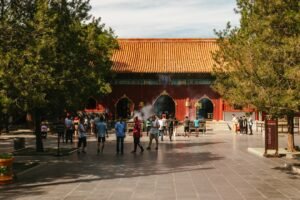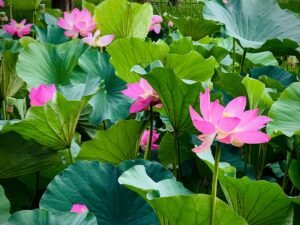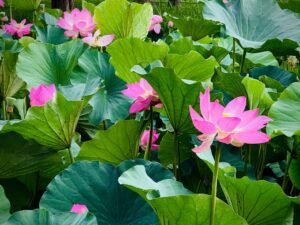

Blended Learning: Combining Self-Study and Classroom French in Oslo
Blended learning has emerged as a transformative approach in the field of education, particularly in language acquisition. This innovative method combines traditional face-to-face instruction with online learning, creating a dynamic and flexible educational experience. In the context of language learning, such as French courses offered at the NLS Norwegian Language School in Oslo, blended learning allows students to engage with the language in diverse ways, catering to various learning preferences and lifestyles.
The integration of technology into the classroom not only enhances the learning experience but also prepares students for a world where digital communication is increasingly prevalent. At the NLS Norwegian Language School, the incorporation of blended learning into French courses has proven to be particularly effective. Students benefit from a structured curriculum that includes both in-person classes and online resources, enabling them to practice their language skills outside the classroom.
This dual approach fosters a more comprehensive understanding of the language, as students can reinforce what they learn during lessons through interactive online exercises and multimedia content. As a result, blended learning not only enriches the educational experience but also empowers students to take charge of their own learning journey. Ready to say Bonjour to fluency? Your French journey starts at NLS Norwegian Language School.
Table of Contents
ToggleSummary
- Blended learning combines traditional classroom teaching with online learning methods to enhance language education.
- The benefits of blended learning include flexibility, personalised learning, and increased engagement and motivation.
- Self-study methods for learning French can include online courses, language apps, and language exchange programmes.
- The classroom plays a crucial role in language learning by providing opportunities for interaction, practice, and feedback.
- Oslo has successfully implemented blended learning in language education, using technology to enhance the learning experience.
The Benefits of Blended Learning
The advantages of blended learning are manifold, particularly in the context of language education. One of the most significant benefits is the flexibility it offers. Students can access online materials at their convenience, allowing them to study at their own pace and revisit challenging concepts as needed.
This flexibility is especially beneficial for those balancing work or other commitments alongside their language studies. At NLS, students can engage with French language resources whenever it suits them, making it easier to integrate language learning into their daily lives. Moreover, blended learning promotes a more personalised approach to education.
With a variety of online tools and resources available, students can tailor their learning experiences to suit their individual needs and preferences. For instance, some may prefer interactive games and quizzes, while others might gravitate towards video lessons or podcasts. This adaptability not only keeps students engaged but also caters to different learning styles, ensuring that each student can find a method that resonates with them.
In this way, blended learning at NLS enhances the overall effectiveness of French language acquisition.
Self-Study Methods for Learning French

Self-study is a crucial component of blended learning, particularly for language learners who wish to reinforce their classroom instruction. There are numerous self-study methods available for those looking to improve their French skills outside of formal lessons. One effective approach is the use of language learning apps, which often incorporate gamified elements to make studying enjoyable and engaging.
These apps can help students build vocabulary, practice pronunciation, and even engage in conversational exercises, all at their own pace. Another valuable self-study method is the use of online resources such as podcasts and YouTube channels dedicated to French language learning. These platforms provide students with exposure to authentic spoken French, helping them develop listening skills and comprehension.
Additionally, reading French literature or news articles can significantly enhance vocabulary and grammar understanding. By incorporating these self-study methods into their routine, students at NLS can create a well-rounded language learning experience that complements their classroom instruction.
The Role of the Classroom in Language Learning
While self-study is essential in a blended learning environment, the role of the classroom remains paramount in language education. Face-to-face interaction with instructors and peers provides invaluable opportunities for practising speaking and listening skills in real-time. At NLS, experienced teachers guide students through structured lessons that focus on grammar, pronunciation, and conversational skills.
This direct interaction fosters a supportive atmosphere where students can ask questions, receive immediate feedback, and engage in meaningful discussions. Furthermore, classroom settings encourage collaboration among students, which is particularly beneficial for language learners. Group activities and pair work allow students to practise their French in a social context, helping to build confidence and fluency.
The dynamic nature of classroom interactions also exposes learners to different accents and dialects, enriching their understanding of the language as it is spoken in various contexts. Thus, while self-study is an integral part of blended learning, the classroom remains a vital space for developing practical language skills.
Implementing Blended Learning in Oslo
The implementation of blended learning in Oslo has been met with enthusiasm from both educators and students alike. Institutions like NLS have embraced this approach by integrating technology into their French courses, creating an engaging and effective learning environment. The school has invested in high-quality online resources that complement its curriculum, ensuring that students have access to a wealth of materials that cater to different aspects of language learning.
Moreover, NLS has fostered a culture of innovation among its teaching staff, encouraging them to explore new methods and tools that enhance the blended learning experience. This commitment to continuous improvement ensures that students receive a modern education that reflects current trends in language acquisition. As Oslo continues to evolve as a hub for education and culture, the successful implementation of blended learning at institutions like NLS positions it as a leader in language education.
Technology and Blended Learning

Technology plays a pivotal role in the success of blended learning initiatives. In the context of French courses at NLS, various digital tools are employed to facilitate language acquisition and enhance student engagement. Learning management systems (LMS) allow instructors to organise course materials, track student progress, and provide feedback efficiently.
These platforms also enable students to access resources anytime and anywhere, making it easier for them to stay on track with their studies. Additionally, technology fosters collaboration among students through online discussion forums and group projects. These digital spaces encourage learners to communicate in French outside of the classroom setting, further reinforcing their skills.
Video conferencing tools also allow for virtual classes or conversation practice sessions with native speakers or fellow learners from around the world. By leveraging technology effectively, NLS creates an immersive and interactive environment that enriches the overall language learning experience.
Overcoming Challenges in Blended Learning
Despite its many advantages, blended learning does present certain challenges that educators must address to ensure its effectiveness. One common issue is the potential for students to become disengaged when relying too heavily on online resources without sufficient guidance from instructors. To combat this challenge, NLS emphasises the importance of maintaining a balance between online and face-to-face instruction.
By providing structured support and regular check-ins with students, teachers can help keep learners motivated and accountable. Another challenge lies in ensuring that all students have equal access to technology and internet connectivity. In Oslo, where digital infrastructure is generally robust, this issue may be less pronounced; however, it remains essential for educators to be mindful of potential disparities among students.
NLS actively works to provide resources and support for those who may struggle with technology access or usage, ensuring that every student has an equal opportunity to succeed in their French studies.
The Importance of Language Immersion in Blended Learning
Language immersion is a critical aspect of effective language education, and blended learning can facilitate this experience in unique ways. At NLS, immersion opportunities are integrated into the curriculum through cultural events, conversation clubs, and partnerships with local French-speaking communities. These experiences allow students to practise their language skills in authentic contexts while also gaining insight into French culture.
Moreover, online resources can further enhance immersion by providing access to authentic materials such as films, music, and literature from French-speaking countries. By engaging with these resources outside of class time, students can deepen their understanding of the language while also developing cultural awareness. This holistic approach to language immersion not only enriches the educational experience but also fosters a genuine appreciation for the French language and its diverse cultural heritage.
Tailoring Blended Learning to Individual Learning Styles
One of the most significant advantages of blended learning is its ability to cater to individual learning styles. At NLS, instructors recognise that each student has unique preferences when it comes to acquiring new knowledge. By offering a variety of online resources alongside traditional classroom instruction, educators can create a personalised learning experience that resonates with each student.
For instance, visual learners may benefit from video content and infographics that illustrate grammatical concepts or vocabulary usage. Auditory learners might find podcasts or audio recordings particularly helpful for developing listening skills. Meanwhile, kinesthetic learners may thrive through interactive activities or hands-on projects that allow them to engage with the language physically.
By tailoring blended learning experiences to accommodate these diverse styles, NLS ensures that all students have the opportunity to succeed in their French studies.
The Future of Blended Learning in Language Education
As technology continues to advance and reshape educational landscapes worldwide, the future of blended learning in language education looks promising. Institutions like NLS are at the forefront of this evolution, continually adapting their approaches to meet the needs of modern learners. The integration of artificial intelligence (AI) and machine learning into language education holds great potential for personalising learning experiences even further.
In addition to AI-driven tools that can assess student progress and provide tailored feedback, virtual reality (VR) may soon play a role in immersive language experiences. Imagine being able to practise conversational French while virtually exploring Paris or interacting with native speakers in real-time through VR technology! As these innovations become more accessible, blended learning will likely evolve into an even more engaging and effective method for acquiring new languages.
The Success of Blended Learning in Oslo
In conclusion, blended learning has proven to be an effective approach for teaching French at the NLS Norwegian Language School in Oslo. By combining traditional classroom instruction with innovative online resources, educators create a dynamic environment that caters to diverse learning styles while promoting flexibility and engagement. The success of this model is evident in the positive outcomes experienced by students who benefit from both structured lessons and self-directed study opportunities.
As Oslo continues to embrace blended learning as a cornerstone of its educational landscape, institutions like NLS will undoubtedly play a pivotal role in shaping the future of language education. With ongoing advancements in technology and an unwavering commitment to student success, blended learning will remain an essential tool for fostering linguistic proficiency and cultural understanding among learners in Oslo and beyond.
If you want to learn Norwegian, you can register for classes here. We look forward to hearing from you and helping you become fluent in Norwegian.





